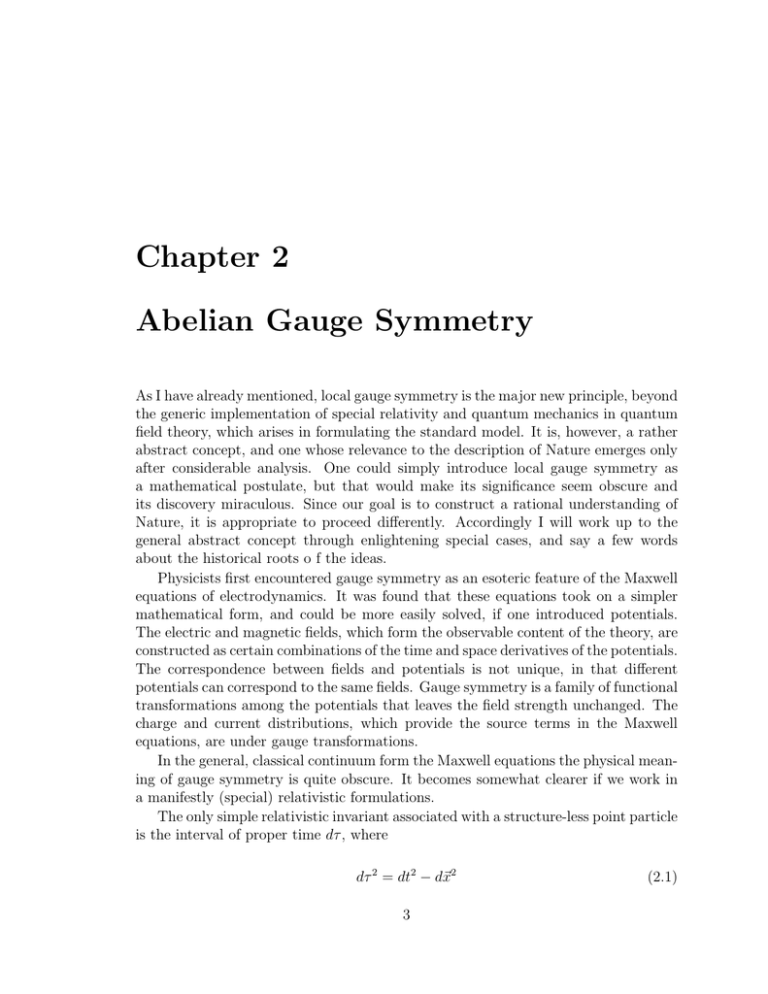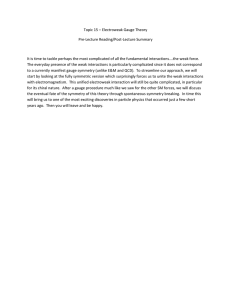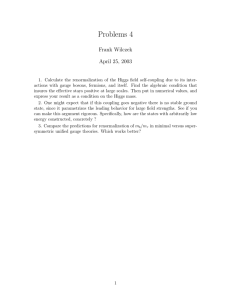Document 13650507
advertisement

Chapter 2 Abelian Gauge Symmetry As I have already mentioned, local gauge symmetry is the major new principle, beyond the generic implementation of special relativity and quantum mechanics in quantum field theory, which arises in formulating the standard model. It is, however, a rather abstract concept, and one whose relevance to the description of Nature emerges only after considerable analysis. One could simply introduce local gauge symmetry as a mathematical postulate, but that would make its significance seem obscure and its discovery miraculous. Since our goal is to construct a rational understanding of Nature, it is appropriate to proceed differently. Accordingly I will work up to the general abstract concept through enlightening special cases, and say a few words about the historical roots o f the ideas. Physicists first encountered gauge symmetry as an esoteric feature of the Maxwell equations of electrodynamics. It was found that these equations took on a simpler mathematical form, and could be more easily solved, if one introduced potentials. The electric and magnetic fields, which form the observable content of the theory, are constructed as certain combinations of the time and space derivatives of the potentials. The correspondence between fields and potentials is not unique, in that different potentials can correspond to the same fields. Gauge symmetry is a family of functional transformations among the potentials that leaves the field strength unchanged. The charge and current distributions, which provide the source terms in the Maxwell equations, are under gauge transformations. In the general, classical continuum form the Maxwell equations the physical mean­ ing of gauge symmetry is quite obscure. It becomes somewhat clearer if we work in a manifestly (special) relativistic formulations. The only simple relativistic invariant associated with a structure-less point particle is the interval of proper time dτ , where dτ 2 = dt2 − d�x2 3 (2.1) 4 CHAPTER 2. ABELIAN GAUGE SYMMETRY This motivates the action � with Lf ree momentum √ � − �v 2 � Sf ree = −m dτ = − dt m 1 ≡ dtLf ree (2.2) √ = −m 1 − �v 2 , where v is of course the velocity. This leads to the pjf ree = vj ∂Lf ree √ = m ∂ẋj 1 − v2 (2.3) which has the expected form for a free particle, and identifies m as the mass. (Note that the spatial momentum pj = −pj .) To couple this particle to a “vector” field Aµ (�x, t) – whose components we shall from here on call potentials – we add to the action a term Sint. = −q corresponding to the Lagrangian � Aµ dxµ dxj . dt The momentum is now, with L ≡ Lf ree + Lint. , Lint. = −qA0 + qAj pj = and Since ∂L vj √ = m + qAj 2 ∂ ẋj 1−v (2.4) (2.5) (2.6) dpj d mv j ∂Aj ∂Aj dxj . = (√ + q ) + q dt 1 − �v 2 dt ∂xk dt ∂t (2.7) ∂L ∂A0 ∂Ak dxk = −q + q ∂xj ∂xj ∂xj dt (2.8) the equation of motion dpj dt = ∂L ∂xj becomes d mv j ∂Ak ∂Aj dxk ∂A0 ∂Aj (√ ) + ( − − ) ) = q(− dt 1 − �v 2 ∂xj ∂t ∂xj ∂xk dt (2.9) d�p � + �v × B) � = q(E dt (2.10) Separating out the terms on the right hand side which contain the velocity, and adopting vector notation, we can write the equation of motion as 5 with Ej ≡ − ∂A0 ∂Aj − ∂xj ∂t (2.11) and B j ≡ �jlm ∂Al ∂xm (2.12) � and B � as electric and magnetic field strengths, we thereby arrive at Identifying E the Lorentz force law for a particle of mass m, charge q. Note that with this identification two of the Maxwell equations, viz. ∂B j =0 ∂xj ∂E l ∂B j �jlm m + =0 ∂x ∂t (2.13) (2.14) are satisfied identically. Historically, this was one main motivation for introducing the potentials A0 and Aj . Another was their appearance in the expressions for the conserved energy and momentum, respectively, of charged particles. Here we have seen how naturally potentials arise in the quasi-geometric framework of relativistic point particle kinematics. The transformation A�µ = Aµ + ∂µ χ (2.15) where χ is a smooth function of space and time that vanishes at infinity, manifestly leaves the action Sint. invariant, �as long as the world-line has no ends. Indeed, one can simply integrate by parts in dxµ ∂µ χ. Equation 2.15 is the transformation that defines local gauge symmetry. Since local gauge symmetry leaves the equation of � and B � unchanged, as of course one can verify motion unchanged, it must leave E directly. Clearly, the requirement that the world-line of a charged particle should have no ends is closely related to the conservation of charge. More generally, the necessary and sufficient condition for an action Sint. = − � d3 xdt Aµ j µ (2.16) to be invariant under local gauge symmetry (i.e, with the gauge function χ van­ ishing at infinity) i s the “continuity equation” 6 CHAPTER 2. ABELIAN GAUGE SYMMETRY ∂j µ = 0. (2.17) ∂xµ To construct the quantum theory it is important to consider the Hamiltonian formulation. The prescription H = p· � �v − L (2.18) together with our formula for p� and L leads to the numerical expression m + qA0 (2.19) 1 − v2 but to consummate the formalism we must eliminate v in favor of p. Fortunately, by grouping the momentum with potential and squaring we find H=√ � 2 1 (�p − qA) − 1 = 1 − v2 m2 and after some simple algebra we derive H= � � 2 + qA0 . m2 + (�p − qA) (2.20) (2.21) The appearance of square root here leads to difficulties in quantization. In order to implement the commutation relations, or (more heuristically) wave-particle duality, one would like to make the substitution p� → −i∂� and implement the Schr¨odinger . But that substitution renders the Hamiltonian, with its wave equation Hψ = i ∂ψ ∂t square root, into a nasty, nonlocal operator. One could try to work with the square of the Hamiltonian, but then there would be negative as well as positive energy solution. It was considerations like these that lead Dirac to Dirac equation. Since an adequate treatment of relativistic quantum theory in any case seems to require that we pass from a point particle to a quantized field description of the charge matter, for present purposes it is preferable to retreat to the non-relativistic limit of H, � 2 (�p − qA) + qA0 . (2.22) 2m Now there is no difficulty in making the above-mentioned substitution and formu­ lating the Schrödinger wave equation, which becomes H =m+ � 2 (−i∂� − q A) ∂ψ (2.23) = (m + + qA0 )ψ ∂t 2m (Of course, the constant term m on the right hand side can be eliminated by absorbing a factor e−imt into ψ.) i 7 For the gauge transformation A�µ = Aµ + ∂µ χ on the potentials to leave the Schrödinger equation invariant, it must be accomplished by the transformation ψ � = e−iqχ ψ (2.24) on the charged fields. Note that the value of charge q appears explicitly in this transformation law. Note also that the complex nature of the field is essential, since the transformation involves multiplication by a phase factor. 8 CHAPTER 2. ABELIAN GAUGE SYMMETRY 2.1 Gauge Symmetry for Quantum Fields Since quantum fields associated with charged particles can create one-particle states whose wave-functions obey the single-particle Schrödinger equation, we should expect that under a gauge transformation such fields transform as in Equation 2.15. It is possible and proves fruitful to consider reversing the logic, by taking the symmetry law as primary. Indeed, suppose that we have several quantum fields ψ1 , ψ2 , · · · with charges q1 , q2 , · · · . Then the condition that an interaction term of the general form ΔL = ψ1p1 ψ2p2 · · · (2.25) which may also contain derivations, should conserve charge is that p 1 q1 + p 2 q2 + · · · = 0 (2.26) for the term destroys p1 particles charge q1 , p2 particles charge q2 , and so forth (or creates an equivalent number of anti-particles). Putting it differently, the necessary and sufficient condition for charge conservation is invariance under the symmetry ψn� = e−iqn χ (2.27) where χ is a real number variable. (Complex numbers are not allowed. They would resale the magnitude of the fields. While they might leave the classical action invariant, they generally spoil the commutation relations.) If there are derivative terms, we cannot allow χ to be a field depending on space and time, because the derivatives ∂µ ψn transform as ∂µ ψn� = e−iqn χ (∂µ χn − iqn ∂µ χψn ). (2.28) The complicated inhomogeneous form of this transformation law makes it diffi­ cult to form invariant interaction terms containing derivatives. But in order to obtain sensible equations of motion it is necessary to have derivative terms in the action. So if we want to promote charge conservation to ]it local gauge symmetry, permit­ ting transformations in which χ depends on space and time, we must modify the derivatives. A suitable modification is suggested by our earlier discussion of the point particle Hamiltonian. We define the covariant derivative operate Dµ to act on a field ψn of charge qn according to Dµ ψn = (∂µ + iqn Aµ )ψn . Then if Aµ transforms as in Equation 2.15, we have (2.29) 2.1. GAUGE SYMMETRY FOR QUANTUM FIELDS Dµ� ψn� = (∂µ + iqn A�µ )e−iqn χ ψn 9 (2.30) = e−iqn χ (∂µ − iqn ∂µ χ + iqn Aµ + iqn ∂µ χ)ψn = e−iqn χ Dµ ψn . Thus the covariant derivative of ψn transforms in the same way as ψn itself, and there is no difficulty in using it to form invariant interaction terms.






